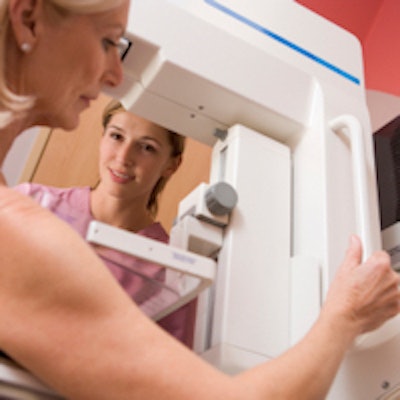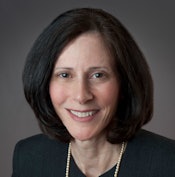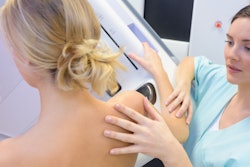
They say a leopard can't change its spots, a truism that fits the U.S. Preventive Services Task Force (USPSTF). On January 12, the group released its final recommendations for screening mammography -- and the guidelines offer nothing new when compared to both the USPSTF's April draft recommendations and its 2009 version.
The task force is staying the course, giving screening for women younger than age 50 a "C" recommendation (indicating a test in which the net benefit is small, so the service should be offered to selected patients depending on individual circumstances). For women ages 50 to 74, breast screening got a "B" recommendation (net benefit is moderate to substantial, so offer the service), while screening for women older than age 75 got an "I" recommendation, which states that the balance of benefits and harms cannot be determined (Annals of Internal Medicine, January 12, 2016).
 Dr. Debra Monticciolo, chair of ACR's breast imaging commission.
Dr. Debra Monticciolo, chair of ACR's breast imaging commission.So because the USPSTF's guidance hasn't changed, the million-dollar question persists: How will these recommendations really affect breast cancer screening going forward into 2016 and beyond?
It's likely they will continue to put a damper on screening rates, especially for younger women, Dr. Debra Monticciolo, chair of ACR's breast imaging commission, told AuntMinnie.com.
"It's really disappointing that the USPSTF has put out these national guidelines without having an evidence-based metric for assessing mammography's benefits versus its risks," she said. "It's reasonable for women to know what to expect from mammography, but we need to be clear that starting screening at age 40 has tremendous benefit in terms of reducing mortality from breast cancer. Screening less isn't going to make cancers go away."
Congressional action
Critics of the USPSTF's recommendations have expressed concern that they will negatively affect coverage of mammography for women younger than age 50. The Patient Protection and Affordable Care Act (ACA) requires private insurers to cover exams or procedures given a grade of "A" or "B" by the USPSTF with no copay (Medicare determines coverage separately).
Giving routine screening of women ages 40 to 49 a grade of "C," while only giving a "B" grade to biennial screening for women ages 50 to 74, suggests that coverage under the ACA for annual screening in each of these patient populations could be affected.
Fortunately, in December, President Barack Obama signed the Consolidated Appropriations Act of 2016 (HR 2029) into law, which includes a provision that delays implementation of the USPSTF's 2015 recommendations on breast cancer screening, continuing mandatory insurance coverage for two years so the changes can be thoroughly vetted.
Will this be enough to mitigate the effect of the recommendations on screening practices, at least in the short term? It's not clear, according to Monticciolo.
"It's possible that the fact that this legislation delays implementation of the USPSTF's breast cancer screening guidelines will prompt women to jump in and get screened," she said. "But we really need a more permanent moratorium."
No impact on coverage?
The USPSTF's guidelines have nothing to do with insurance coverage, according to the lead author of the guidance, Dr. Albert Siu, an internist at the Icahn School of Medicine in New York City. In an editorial that accompanied the recommendations, Siu's group wrote that coverage decisions are the domain of payors, regulators, and legislators, not the task force.
"Whatever we may believe about the importance of coverage in shared decisions about mammography, we cannot exaggerate our interpretation of the science to ensure coverage for a service," the team wrote. "This would lead to confusion regarding the state of science versus the politics of coverage."
And Siu's team also took pains in the editorial to make clear that the recommendations do not forbid women younger than 50 from getting regular screening mammography, but instead emphasize that women should be empowered to make informed choices.
"The USPSTF believes that women who understand the harms but value any chance of reducing their risk for dying of breast cancer, even if small, should be able to make an informed decision to begin screening in their 40s," the group wrote. "[We] fully support the shift toward shared decision-making that is emerging within the mammography debate, and we are glad to see that it is part of a larger movement toward empowering patients with information not only about the benefits but also the harms of preventive services."
But the USPSTF's comments on this issue are disingenuous, Monticciolo said.
"The task force can say that their recommendations shouldn't affect insurance coverage, but they do," she told AuntMinnie.com. "The group is trying to distance itself from the fact that they're putting a cost value on women's lives. A 'C' recommendation doesn't inspire insurers to cover a service."
Douse the flames?
In another editorial published with the guidelines, Dr. Christine Laine, editor in chief of the Annals of Internal Medicine, and colleagues argued that it's time to "douse the firestorm around breast cancer screening." Quoting Dr. Otis Brawley, chief medical officer of the American Cancer Society, Laine's group wrote, "Americans have been taught to fear cancer and have blind faith in screening with too little appreciation of its limitations and harms."
"Guidelines that mislead women about the net health benefits they can expect from mammography would disrespect our mothers, wives, daughters, and sisters," Laine and colleagues wrote. "Let's douse the flames and clear the smoke so that we can clearly see what the evidence shows."
An admirable appeal, but one that requires agreement on whether the USPSTF's science is trustworthy -- and clear communication to women and their referring physicians, according to Monticciolo.
"The evidence the guidelines cite is confusing, not just for women, but for the referring physicians who write the prescription for the mammography exam," she said. "The task force seems to decide on a conclusion and then fit the evidence to support that conclusion. They're very selective in the data they present."




















